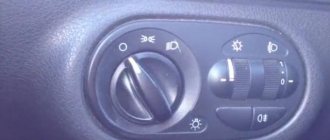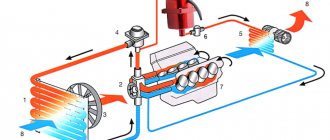It's no secret that modern cars are simply “stuffed” with all kinds of electronic systems to assist the driver. More recently, a car owner could be proud that his car is equipped with an anti-lock braking system (ABS), and the presence of an exchange rate stability system (ESP) put his vehicle on the same level as a spaceship or Mars rover. This is of course a joke, but it really reflects the state of things in the domestic automobile market in the 2000s.
Next, I will talk about an assistant that has recently become available to a wide range of motorists - launch control.
Launch control from A to Z: what it is, how it works, what it’s for
Modern cars include an installation called launch control, which allows you to control the vehicle’s power plant. The unit is an extremely complex product, capable of controlling various components - this allows the driver to concentrate on the task.
However, it's not just racers who can benefit from the product - everyday commuting can also require instantaneous acceleration that isn't possible with normal throttle input.
Launch Control - involves starting the vehicle without slipping, helping to accurately distribute engine power.
History of launch control creation
Instant start is an excellent quality of professional drivers, available only to racing aces. The mastery and development of technology was provoked by the evolution of telemetry. In 1985, the Renault team was able to create technology that allows signals that optimize the operation of systems to be transmitted remotely. Previously, it was only possible to read information, without any assistance in the race.
Years later, the development of technology forced the FIA corporation to ban the use of such an innovation for participants in Formula 1 teams. According to experts, electronic assistants significantly reduce the level of pilot skill, which negatively affects the quality of races.
Then there were years of controversy and debate that led to the implementation of the development. After which, at the end of 2004, the federation again canceled its decision, justifying it with the excessive cost of launch control for low-budget teams. The development price tag will not be affordable for simple organizations, which can lead to a significant reduction in the number of competition participants.
Why do you need launch control?
The answer to the question why this device is needed is simple. The presence of launch control in the car implies the ability to accurately calibrate the speed of the power plant to make an instant start while minimizing the effect of slipping.
The benefit of the technology is especially pronounced in racing modes, where fractions of seconds count. For example, the operation of the unit is especially in demand in drag racing.
The idea is simple, for an optimal start the rider needs to maintain optimal speed to make an ideal start. Immediately after starting to move, full throttle is required to effectively gain speed.
So, the main essence of the work of launch control is to perform all the necessary actions at the right moment, for minimal loss of time on start and acceleration, fully automatically, without user intervention.
How launch control works
The essence of the installation is based on the ability of the power unit to automatically maintain speed at a given level, followed by a sharp acceleration of the value to the limit.
Launch control is applied automatically due to the ability of electronics to control the process.
On production vehicles, the user simply presses the brake and gas pedal. The automation brings the speed to the desired level, and after releasing the brake, the car rushes forward. However, the device independently determines the necessary parameters - this is due to the fact that an inexperienced user can damage the automatic transmission unit with such actions.
Important! The operation of the device is most effective on engines equipped with an injector.
How to enable and use Launch Control
Depending on the modification of the vehicle, the principle of activation of the block may differ. But the general rules are approximately the same for all models.
- Warm up the power unit and gearbox to the nominal value.
- Set the gearbox position to sport.
- Disable the directional stability option, otherwise the unit will fail.
- Press the brake to the floor.
- Without releasing the brakes, press the gas all the way.
- Wait until the engine reaches 3.5 - 4.5 thousand rpm. The indicator depends on the vehicle model.
- Smoothly release the brake.
If everything is done correctly, the car will begin to rapidly accelerate until it reaches maximum speed. To reset, you just need to let off the gas.
Important! The correct operation of the unit depends on the correct manipulations of the driver. Before starting, you must carefully study the factory manual.
Setting up Launch Control
The function setting is available exclusively to race car drivers. It is possible to calibrate the actuation moment and the number of engine revolutions.
During manipulations, the rubber composition, road surface, and air temperature are taken into account.
On serial-type models, the manufacturer enters the necessary data into the firmware; the end user can only activate or disable the option. This is done to ensure that the user does not damage the CP due to lack of knowledge and experience.
Using launch control in production cars
For production cars, the option is available only to top versions of sports cars or at the whim of the manufacturers. The technology has not found widespread use due to its unusually high cost.
Vivid examples where the automatic start function is installed are the following:
- BMW M/X series;
- Bugatti Veyron;
- Porsche 911;
- Nissan GT-R;
- Mitsubishi Lancer X;
- Volkswagen Tiguan;
- Skoda Octavia.
It is also worth noting the most famous manufacturers of automatic start units for cars and motorcycles. These are corporations:
Important! Obtaining an effect similar to the operation of the device can be obtained by honing the skill of working with the gas and brake pedals.
Automatic launch control
The technology is used on automatic transmissions only of a certain type. A conventional automatic transmission cannot provide the necessary parameters due to the inadequacy of the design.
However, with the advent of dual clutch systems, engineers noticed that the designs were subject to modernization. This prompted the use of the design. Launch control on this type of machine is installed by global companies.
Source: https://autodont.ru/jelektro/launch-control
Electronic racer
We were able to test its effect on a Porsche 911 Turbo with a 540-horsepower boxer engine at the Moscow Raceway. The main straight of the track was divided into an acceleration and braking section with a dedicated quarter-mile section (402 m). On it we had to test the technology in action.
The theory says that the more momentum you give the car during the start, the faster it will accelerate. To do this, experienced racers, such as Oleg Keselman, first revved the engine to the red zone, and then threw the clutch pedal in such a way that the maximum torque immediately pushed the car off the ground and it flew out like a cannonball. Further acceleration must be accomplished without wheel slipping, so as not to waste energy. Great skill is required from the driver when operating the gas pedal.
Photo: AiF/Vladimir Gavrilov
Unfortunately, not every person is capable of such a start the first time. Electronics come to the rescue.
Modern launch control used for drag racing cars imitates this algorithm. The Porsche 911 has all the settings already included, and there is no need to tinker with them. You simply switch the drive programmer to the “Sport++” mode, which turns off the traction control and stabilization systems, and then activate the launch control button on the center console.
Tips for launching a mobile game: Part 1, Soft launch
In mobile games, a soft launch is often crucial - especially now, when app stores are oversaturated and you have to invest a lot of money to attract users.
Using a soft launch, you can understand how well the game will be received by users in the event of a global launch, and roughly estimate the costs of its marketing. However, a soft launch can be a time-consuming process - it is not always obvious what to do and what to avoid.
In 2022 alone, we at Nexon held a soft launch of about a dozen games. Through trial and error, we figured out what worked best for our games. Here are some of our best practices.
What is soft launch?
Soft launch occurs before the official launch of the game worldwide. Developers release the game in select regions similar to their target market in order to ensure a successful global launch. You can regard this as training or testing.
Checklist for soft launch
Define the main tasks
It is important to understand that soft launch is primarily a learning process. During this time, you prioritize speed and pure data over ROI, which you can focus on later during the global launch. Your main goal is to collect fast and clean data to make better business decisions later. This data will help you determine your betting strategy and map out your game's LTV curve.
The back of your head on the headrest
Before us is the main straight of Moscow Raceway in front of the high stands. We put the robotic gearbox selector in sport mode D, press the accelerator and hold the brake. You need to press on both pedals at once, and as hard as possible.
Photo: AiF/Vladimir Gavrilov
The engine revs up, roars, and the tachometer needle jumps to the red zone. The electronics itself controls the speed and prevents the engine from spinning up too much. The control unit interrupts signals to the ignition coils to keep it in the maximum power range.
Then we release the brake and the clutch suddenly engages. The Porsche 911 Turbo rushes forward with a wild roar, so much so that you painfully hit the back of your head against the headrest.
At this moment, you need to continue to press the accelerator, without fear that the engine has a power of 540 hp. With. will cause the wheels to slip. The electronics will allow only small slippage and will not allow the power unit to develop more power than is needed for acceleration. As a result, electronics, and not humans, control the process of gaining speed.
Photo: AiF/Vladimir Gavrilov
What is the value of a soft launch for the application owner?
In an environment where mobile app marketing is becoming more expensive and the cost of acquiring users is rising, the issues of preliminary testing of marketing campaigns and the success of the application as a whole are becoming especially important. One way to test the operation of an application or game and explore all aspects of its marketing without incurring large expenses is a soft launch.
Why it's important to do research before the big launch
Marketing is a rather expensive process. And we are talking not only about the money you invest in promotion, but also about the labor costs for creating promotional materials, ASO, community development, communication with the press, influencer marketing, etc. All of these tasks require a lot of time and effort. By doing it at random, you run a very high risk of not getting into the target audience and wasting your efforts and money.
Conducting research will allow you to obtain preliminary data on the operation of the application, identify bottlenecks in which users get stuck or abandon it altogether, predict LTV and CPI, draw up a promotion strategy, formulate and confirm theories about your target audience.
What is a soft launch?
Soft launch (soft launch) - releasing a product (game or application) and testing its operation for a limited market (audience).
In fact, this is a test of your product in combat conditions in order to determine the main parameters of its operation. This is an attempt to predict the future of an application based on a small test group. “You don’t get a second chance to make a first impression,” and the soft launch is just practicing this first impression on a small audience before the global launch.
Typically, a soft launch is conducted in a country that is most similar to the target market, but smaller in size and cheaper in terms of user acquisition costs. For Europe, for example, Finland is often chosen. For Asia - Thailand or Vietnam, and for the USA - Australia or Canada. However, it is quite possible to conduct such testing simply on a relatively small group (one or several states in the USA).
It is important to correctly assess the relevance of this group to the future “large” user base. For example, if you gather several thousand users through a game announcement on a website for developers, then this group will be sufficient for a soft launch, but not at all relevant if your game is intended for teenagers.
Soft launch goals
You'll likely have your own goals for this kind of beta testing, but in general you'll want to answer a few key questions about the product before release:
- How willing are people to click on app ads?
- What creatives of yours work best?
- Is it easy to “sell” your product to your audience?
- Which demographics does the app resonate best with?
- What applications does this segment currently spend its time in and will you be able to squeeze out your competitors?
- At what scale can the application remain profitable?
- How big and profitable can it become?
- How viral is the product?
- Do users share information about it?
When conducting such studies, ensure that the metrics collected are reliable, reflect the quality of the product, and are not the result of chance. By the end of the soft launch, you should have a sufficient amount of data on the behavior of users targeted for your product, their churn, and key indicators of effective marketing. This information will confirm your product hypotheses, and will also help you quickly make the necessary changes to the product before the official launch.
Basic elements and capabilities of programs of this type
Now - just a first look at any Launch Manager. What it is is easy to determine (no matter what system it is designed for). The only thing worth noting here is that each of them has its own standard set of widgets that allow you to access certain functions.
What such toolkit is depends entirely on the software developer. But basically, there are several mandatory elements here, such as a volume control, a Wi-Fi or Bluetooth switch, settings for video mode and screen brightness, or the use of the so-called energy-saving mode (ECO).
Launch control: what it is and how it works
It's no secret that modern cars are simply “stuffed” with all kinds of electronic systems to assist the driver. More recently, a car owner could be proud that his car is equipped with an anti-lock braking system (ABS), and the presence of an exchange rate stability system (ESP) put his vehicle on the same level as a spaceship or Mars rover. This is of course a joke, but it really reflects the state of things in the domestic automobile market in the 2000s.
Next, I will talk about an assistant that has recently become available to a wide range of motorists - launch control.
Purpose
Launch control (launch control) is an electronic system that allows you to achieve the most efficient start of a car from a standstill. This is achieved by controlling the fuel supply and ignition systems.
In other words, the Launch control system raises the engine speed before the start of movement, so that in the process of starting from a standstill, the engine has already reached the speed necessary for an effective start. This is especially true for turbocharged engines, where the turbine needs to spin up, so to speak, “inflate”. The use of this system practically equalizes the start of an experienced racer and a novice driver. Launch control eliminates driver errors when starting, and also allows you to use engine power and torque as efficiently as possible.
Engineers have been thinking about the development of this system almost since the appearance of the first races. And when such a type of competition as Drag Racing, where you need to overcome 402 meters as quickly as possible, began to gain popularity, it was simply impossible to do without a launch control system in the car. After all, the entire race lasted just over 10 seconds, and the winner was often determined by hundredths of a second. A participant who made a mistake at the start most likely lost the entire race.
How does it work
The principle of operation is that the engine speed at start is kept at the maximum torque mark. As a rule, this is 2000–4500 rpm.
Until recently, Launch control was used only on cars equipped with a manual transmission. This is due to the fact that automatic transmissions were either hydromechanical automatics or CVTs, where the clutch function was performed by a torque converter.
I will not go into the design features of the torque converter and will immediately move on to the most important thing, and this is that the torque converter extremely does not like increasing speed at the start and this greatly affects its service life.
It was only in the early 2000s that the Launch control system began to be used on automatic transmissions. This became acceptable due to the widespread use of another type of automatic transmission - preselective robotic gearboxes, the most famous of which is DSG (aka s‑tronic) from the VAG concern (Volkswagen, Audi, Skoda, Seat). Structurally similar gearboxes are available in BMW, Porsche, the Japanese - Nissan GTR, Mitsubishi Lancer Evolution 10, and even recently the Koreans.
Structurally, these boxes are more similar to mechanics and do not have the disadvantages of hydromechanical gearboxes.
By the way, if your car is not equipped with launch control, then it is quite likely to find the firmware of the engine control unit, where this system will be registered.
Application of Launch control or how to enable it
Let me make a reservation right away that there is no key as such to turn on Launch control. However, certain actions must be taken and conditions must be met:
- Starting from launch control must be carried out with a warm engine and gearbox, that is, it is not enough to stand for 10–15 minutes with the engine running, since in this case only the internal combustion engine will be warmed up, you need to drive at least 10 km so that the gearbox also operates at the required temperature mode;
- Disable the ESP stabilization and stability control system; Switch the gearbox selector to S (sport) mode;
- Leave your left foot on the brake pedal, and move your right foot, which was not previously used, to the fuel pedal;
- Press on the gas (the system will set the number of revolutions itself) and release the brake; Enjoy lightning-fast acceleration)))
I wanted to add a few words about safety to make overclocking safe. Launch control is not installed on all cars; it is installed on powerful and high-speed cars. Therefore, during intense acceleration, make sure that the road surface allows maximum torque to be realized on the drive wheels and that rapid acceleration will not interfere with other road users.
Now you know what launch control is, I hope the article was useful to you. See you soon!
Andrey
Source: https://avto-kul.ru/poleznoe-ob-avtomobile/launch-control.html
Robot only
For a long time, launch control was only available on cars with a manual transmission.
On automatic machines with a torque converter, this is not possible, as there is a risk of damage to the torque converter. Now, with the introduction of preselective robotic boxes, launch control has been developed for them as well. The most famous is the DSG gearbox on Volkswagen, which in a reinforced form is also available on sports models. Instead of a torque converter, there is a dual-clutch package, which copes much better with sudden starts.
Article on the topic
They came up with all sorts of things. Modern options in cars that scare beginners Therefore, the standard launch control mode can be seen on a number of Volkswagen cars. Such a box is now equipped with Scoda Octavia, Volkswagen Tiguan and other models with turbocharged engines.
The BMW M-series with a similar preselective robotic transmission has launch control. It is available not only on the Porsche 911 Turbo we tested, but also on the Panamera Turbo with the PDK Doppelkupplung sports robot.
According to Oleg Keselman, a driver who does not have special training in street racing can only achieve maximum rated acceleration on these cars using launch control.
Launch Control is one of the car's sport options
Most drivers, even if they have heard about such a function on cars as Launch Control, do not fully understand what it is.
Meanwhile, in motorsport, some time ago, it was in great demand, and even now discussions about its use on sports cars continue.
What is Launch Control for?
At the dawn of the development of motorsport, the standard of driver skill was considered to be their ability to take off quickly without losing traction of the wheels with the ground, since their “slippage” at high speeds led to a significant loss of time at the start.
The installation of electronic units on the cars, which made it possible to maintain optimal starting speeds, eliminating wheel slippage, with the gas pedal fully recessed, freed drivers from the need to improve their skills. At its core, Launch Control is the same launch master, but in electronic form.
How Launch Control was created
The creation of Launch Control began after engineers in 1985 learned to remotely receive signals from the sensors of their cars and transmit information to them that optimized the operation of individual systems. Two-way telemetry contributed to the further development of electronics, including the appearance of electronic units that control optimal speed at the start.
Because electronics have developed so rapidly that they have completely eclipsed the skill of racers, the International Automobile Federation (FIA) was forced to ban the use of Launch Control in Formula 1 racing. After some time, she again allowed their use, and in 2004 she banned them again, but for reasons of accessibility of these competitions for poor teams, since the development of new electronic systems requires significant financial investments.
Maximum turbine pressure
It's no secret that in the absence of accessible car tracks, the main sporting entertainment for street street racers is quarter-mile drag racing. The rules are simple. A straight and relatively uncongested section of the road is selected, and a platform is prepared for races with a temporary start and finish.
Article on the topic Men's "games" in the fresh air. What are off-road races like? Two cars start at the same time, and the winner is the race participant who develops the highest speed on a 402 m straight line. This is a race for maximum acceleration, and the battle is fought in hundredths of a second.
Naturally, the winning strategy here fits into one simple rule. Whoever starts better has a better chance of winning. And this can only be done when the engine reaches full power. A smooth start, as in everyday life, is not suitable here.
The clutch opens, and the engine with the turbocharger is spun up by gas to such speeds as to maintain full boost at the moment of start, that is, the maximum pressure of the turbine. Launch control is a great help here.
What is a product launch
Product launch is the launch of a new product on the market. This is the stage when the product is already completely ready, and the main goal is to convince a potential buyer to purchase it. To achieve this, you need an active, well-thought-out marketing campaign. Practice shows that the buyer does not look for a new product on his own, therefore, if you want to ensure maximum demand before the start of the sale, you need to convey information to the consumer and arouse his interest in the product.
Why launch is so important
By the time a product is introduced to the market, a lot of effort, time and money have already been invested in development and production. If the launch is carried out correctly, then from the first days on the market the product will begin to recoup the investment, and subsequently make a profit. However, the slightest mistake during the launch period will lead to the fact that there will not be enough demand for the product, and, instead of the expected profit, the company will incur additional losses. To avoid this, you need to be well prepared before launching a product on the market.
Preparing for launch
Preparing a product for launch consists of many aspects: idea development, budgeting, production, documentation preparation and many others. In this article we will focus only on those points that relate to product promotion on the market.
Determining the target audience
Try to understand as clearly as possible who your potential buyer is and who will be interested in this product. The more precisely you define the market segment you will work with, the better you can study its habits, preferences and capabilities. Thanks to this, advertising and product promotion will be consumer-oriented, which means costs will decrease and sales will increase.
If you decide to release a new type of child car seat, target car owners aged 25 to 45 who have small children. Naturally, people who do not fit these parameters can buy a car seat, but they are not your main target audience.
Studying competitors
Absolutely unique products rarely appear on the modern market; as a rule, your product will have analogues. Before launching a product, find out what similar products are on the market and which companies will be your main competitors. Studying the work of competitors will help you determine their strengths and weaknesses, as well as understand what the demand for this category of goods is and how often they are purchased. From this you will calculate the estimated sales volume of the new product.
If you decide to open a music school, find out:
- What music schools exist in the city or region.
- What percentage of children attend music schools?
- What level of teaching do competitors offer?
- What form of training is most popular?
- What is the cost of education in existing schools.
Determining product benefits
Before you start promoting a product on the market, determine its advantages over existing analogues.
If your company releases a new camera model, the advantages include:
- high quality shooting;
- adaptability to various types of shooting;
- low price;
- ease of use;
- convenient and attractive design.
Secrets of a successful launch
Often, despite proper preparation and quality products, a company fails to achieve expected sales at the launch stage. We'll share a few secrets that will help make your launch more successful.
Timely product launch
Some company owners want to get their product to market as quickly as possible. Others, on the contrary, are delaying the launch in order to better prepare. Each of these approaches has disadvantages, so you need to choose the optimal time.
On the one hand, if you rush to launch a product, the market will not yet be ready for it, and the product itself will not be fully developed. In this case, you will have to spend additional funds on modifications and relaunch of the product. On the other hand, if you launch a product too late, the market will be overcrowded with competitors and the product will become obsolete faster than it is worth the investment.
If you release a new phone model a month after the previous one, most consumers will not be ready to buy it yet. If you are late with the release, all lovers of novelty will already buy a similar model from competitors.
There are additional factors to consider when choosing a time to launch. For some types of products, the right season is important, such as winter boots or scuba diving equipment.
Coordinated team actions
During the launch period, it is important to clearly distribute responsibilities between team members, otherwise any of the items in the launch plan will not be completed. Also, set clear deadlines and stick to them. Inconsistency in actions will lead to additional costs and reduced sales.
If advertising is launched too early, people will want to buy the product, but will not be able to find it because it has not yet gone on sale. On the other hand, if a product hits stores too early, it will gather dust on the shelves until marketers convey information about the product to potential consumers.
Properly targeted advertising
Advertising should be targeted at the target audience and emphasize the advantage of the product over competitors. To achieve this, consider pre-launch market research.
There's no point in spending huge sums of money advertising baby food during a horror movie if your potential customers, young mothers, aren't watching it.
Choose those methods of conveying information that best suit the product and the potential consumer. During the launch period, advertising should be powerful, intense and attention-grabbing. Successful advertising will inform the target audience about the new product, arouse interest and, ultimately, lead to the purchase of the product.











